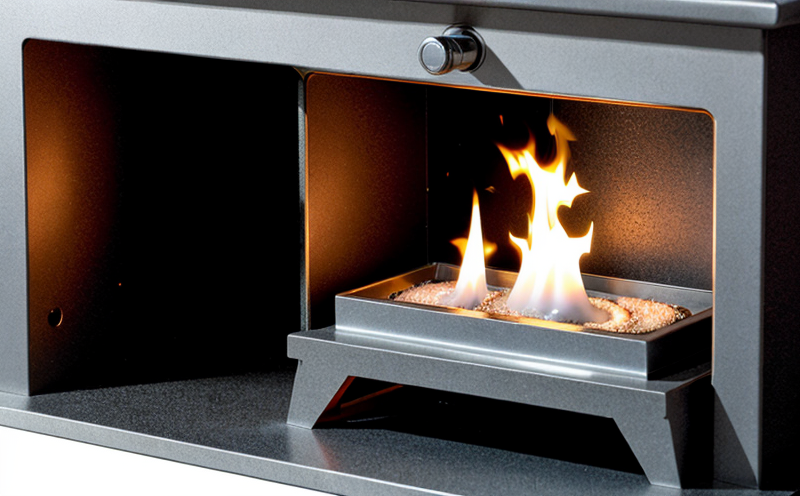ISO 9239-1 Reaction-to-Fire Testing of Floorings
The ISO 9239-1 standard is designed to assess the reaction to fire properties of floor coverings, particularly focusing on their surface flame spread and ignitability characteristics. This test is crucial for ensuring that flooring materials meet stringent safety requirements in buildings intended for residential or commercial use.
During this testing procedure, samples are subjected to a controlled environment where they are exposed to an ignition source, typically a gas burner with a specific jet of butane flame. The time taken by the flaming part of the sample to spread over its surface and the distance it travels within a specified period are key parameters measured.
The test setup includes a specially designed chamber equipped with a burner that can be adjusted for height and position to simulate real-world conditions accurately. The samples are placed horizontally on a metal support grid, ensuring proper ventilation during testing.
For accurate results, the specimens must undergo rigorous preparation processes including conditioning to standard atmospheric conditions (temperature, humidity), trimming to ensure consistent dimensions, and orientation based on their manufacturing direction if applicable.
| Parameter | Description |
|---|---|
| Flame Spread Index (FSI) | The distance the flame travels across a sample within 10 minutes after ignition. Lower values indicate better fire resistance. |
| Ignitability | The ease with which a material catches fire and continues to burn once ignited. |
These parameters are critical in determining the suitability of flooring materials for various environments, including schools, hospitals, offices, and public spaces. The results help architects, builders, and other stakeholders make informed decisions about selecting appropriate floor coverings that comply with local and international safety standards.
- Ensures compliance with building codes and regulations.
- Aids in enhancing the overall fire safety of buildings.
- Reduces liability risks for property owners by choosing safer materials.
The ISO 9239-1 test is not only a technical evaluation but also a vital step towards protecting public health and safety. By adhering to these standards, manufacturers can contribute significantly to reducing the risk of fire-related accidents in densely populated areas.
Why It Matters
The importance of ISO 9239-1 testing cannot be overstated. In case of a fire, flooring materials play a critical role in controlling the spread and intensity of flames. Flammable surfaces can exacerbate the situation, leading to rapid escalation and increased risks for occupants.
By conducting this test, we ensure that only non-flammable or low-flammability floor coverings are used, thereby minimizing potential hazards. This precautionary measure is especially important in high-risk areas where even small sparks could ignite a blaze, such as kitchens, laboratories, and other industrial settings.
The findings from ISO 9239-1 testing help identify materials that can withstand exposure to flames without significant damage or propagation. Such properties are essential for maintaining structural integrity during emergencies and ensuring the safety of people within buildings.
Industry Applications
The applications of ISO 9239-1 testing extend across multiple sectors, including construction, residential development, commercial real estate, and industrial facilities. Here are some specific areas where this standard plays a pivotal role:
| Sector | Application |
|---|---|
| Residential Construction | Evaluating floor coverings for new homes and apartments. |
| Commercial Real Estate | Selecting appropriate flooring materials for office buildings, hotels, and shopping centers. |
| Industrial Facilities | Ensuring safety in areas with high fire risk like factories and warehouses. |
In addition to these sectors, the results of ISO 9239-1 testing are also valuable for:
- Hospitality industry: Hotels and resorts ensure guest rooms have safe floor coverings.
- Education sector: Schools and universities maintain fire safety in classrooms and administrative areas.
- Healthcare facilities: Hospitals and clinics provide a safer environment for patients and staff.
The information derived from these tests informs decisions that directly impact the lives of people who use these spaces daily. It ensures that even in the event of an emergency, occupants are better protected against the dangers posed by flammable materials.
International Acceptance and Recognition
The ISO 9239-1 standard enjoys widespread acceptance across numerous countries worldwide. It is recognized as an authoritative guide for assessing the reaction-to-fire properties of floor coverings, making it a preferred choice among regulatory bodies.
- Australia: The National Construction Code (NCC) mandates compliance with this standard for certain buildings.
- Canada: The Canadian Standards Association (CSA) references ISO 9239-1 in its publications.
- United Kingdom: The UK Building Regulations include provisions based on this standard.
In Europe, the standard is endorsed by the European Committee for Standardization (CEN), and it forms part of several national standards like EN 456. Similarly, in the United States, the American Society for Testing and Materials (ASTM) has incorporated similar requirements into its codes.
| Country | Standard Reference |
|---|---|
| Australia | National Construction Code (NCC) |
| Canada | CAN/CSA-B67-2015 |
| United Kingdom | BRE Digest 348 |
| Germany | DIN EN 456:2009 |
The global recognition of ISO 9239-1 underscores its significance in the realm of fire safety and highlights how it contributes to a safer built environment globally.





